Your Website vs. Amazon: How to Win with Free & Fast Shipping
Give Your Website Customers an Amazon-like Delivery Experience. It’s Easier and Less Expensive Than You Think
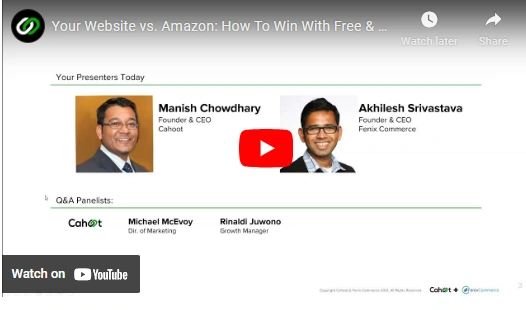
Introduction
Brands and online retailers are losing eyes, sales, and market share to Amazon and other marketplaces. During the 2020 eCommerce boom, overall eCommerce sales grew a record-setting 27%. Marketplaces, though, outstripped that incredible growth rate and came in at 40% YoY. Now, a whopping 62% of global eCommerce sales come from marketplaces. With marketplaces taking as much as 15% commission on each sale, this is no small challenge for online retailers as they watch their mix shift and their margins erode.
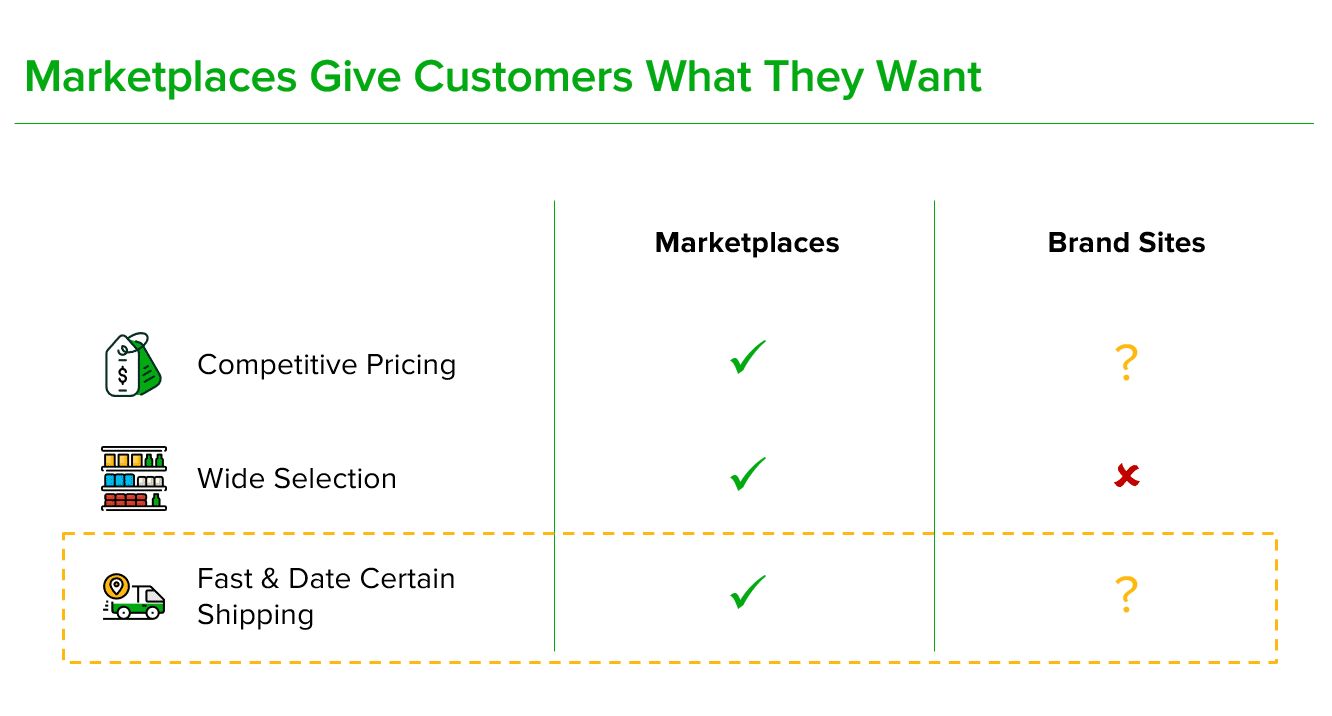
Marketplaces’ strength begins right at the beginning of the customer’s buying process. Their huge selections have made them the place to go to find everything. According to Statista, 63% of consumers start their shopping experience on Amazon, 33% on retailer sites, and only 21% on the websites of brands they want to buy.
On top of that initial strength, marketplaces offer a better delivery experience than brand websites. Shoppers simply won’t buy from merchants’ Shopify, BigCommerce, or Magento stores unless they get fast and free shipping and estimated delivery dates – which are all table stakes on marketplaces like Amazon.
This article and on-demand webinar examine the impact of fast and free shipping and estimated delivery dates on brand website sales. They also offer actionable advice on how merchants can level the playing field with Amazon and boost sales on their most profitable channel – their website. On top of that, merchants can use these same strategies to win the Buy Box on marketplaces such as Amazon, Walmart, and eBay – a winning multichannel strategy.
Read on to discover answers to the most pressing questions for multichannel merchants:
- Exploring the challenge
- Why are marketplaces growing faster than brand websites?
- How are consumer expectations of fast and free delivery shaping eCommerce?
- What’s the impact of fast and free on eCommerce website conversion rates and sales?
- How to deliver an Amazon-like experience on your website
- How can you increase conversion rates and reduce ad spend with fast and free shipping offers?
- How can you offer affordable, fast, and free shipping – everywhere you sell?
Why Marketplaces Are Growing Faster Than Brand Websites
It’s simple. Consumers want a wide selection, competitive pricing, and a great delivery experience. Marketplaces like Amazon give them that, and most websites don’t.
The wide selection found on marketplaces is the first driver of their dominance. It’s similar to why consumers flocked to malls back in the day. With just one destination, shoppers could get just about anything at the right price point. It’s simple, fast, and easy – how can anyone resist? They don’t – 63% of online consumers start their shopping on Amazon, while only 21% start their experience on brand websites. And after drawing buyers onto their platforms, the next aspect of marketplace dominance kicks in.
Marketplaces, and notably Amazon, build on their advantage over brand websites with their fast and free shipping. To wit, a January 2020 survey revealed that fast and free shipping is the single most common reason why US consumers started their shopping experience on Amazon. The company introduced the Prime membership program with free 2-day delivery back in 2005. Fast forward to 2019, and there were an estimated 112m Prime members in the US, each spending an average of over $1,400/year.
On top of this monetary success, Prime has built a wide competitive moat for Amazon. Thanks to Prime, consumers don’t just want fast and free shipping – they expect it. Websites that have slow, expensive shipping don’t stand a chance: 63% of consumers cite high shipping costs and 36% cite slow shipping as the reason they abandon shopping carts (Statista).
No amount of brand loyalty trumps fast and free delivery. In the example below, KIND offers paid 2-day shipping. Not bad, but not good enough to beat the marketplaces. For the identical Dark Chocolate, Nuts & Sea Salt bar, their 2-day shipping costs are almost three times that of Walmart’s 1-day shipping, and of course, shipping is free and just a day on Amazon. Is any customer loyal enough to pay twice as much for a slower delivery?
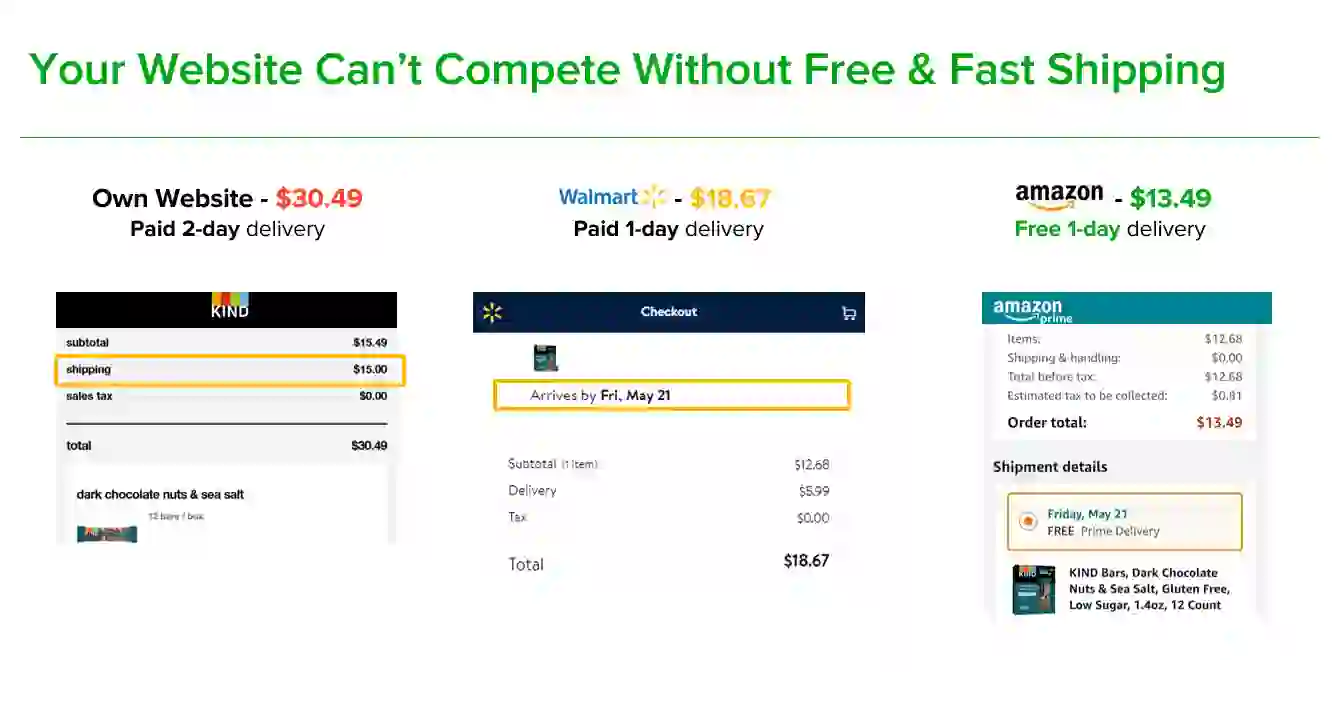
Estimated delivery dates (EDDs) also play a key role in consumers’ preference to shop on Amazon. Customers want to know when they’ll receive that cool new thing they want to buy before putting it in the shopping cart. 64% of shoppers look for delivery options before placing items in the cart (Metapack). Vague delivery times, or worse yet, no delivery times on brand websites create uncertainty and doubt and lower add-to-cart rates.
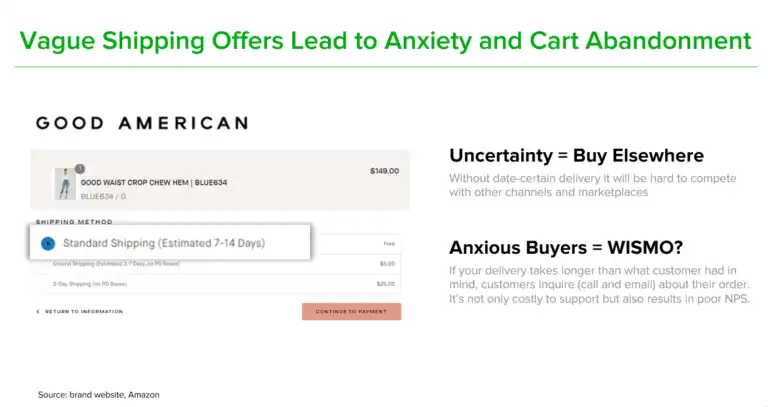
To recap, marketplaces’ multiple powerful advantages over brands and retailers’ online stores drive their share of eCommerce higher. Brands will never be able to compete with their wide selection, but as we’ll soon illustrate, they can level the playing field with a fast, free, and certain-delivery experience.
“Exactly what I was looking for! From the first call to Cahoot, I felt like I could just sit and relax, and the amazing team will make sure everything is taken care of from A to Z. There is ALWAYS someone there ready to help and guide you through the whole process. In short, I feel like I joined a family more then a 3pl.”
– Eli Miller, Newbend
How Consumer Expectations of Fast and Free Delivery are Shaping Ecommerce
What happens on Amazon doesn’t stay on Amazon. Back in 2005 they took the lead when they introduced free 2-day delivery with the Amazon Prime program. They’ve repeatedly pushed the bar higher, and competitors have been on the back foot ever since. Amazon sets a standard, consumers come to expect it, and everyone rushes to catch up.
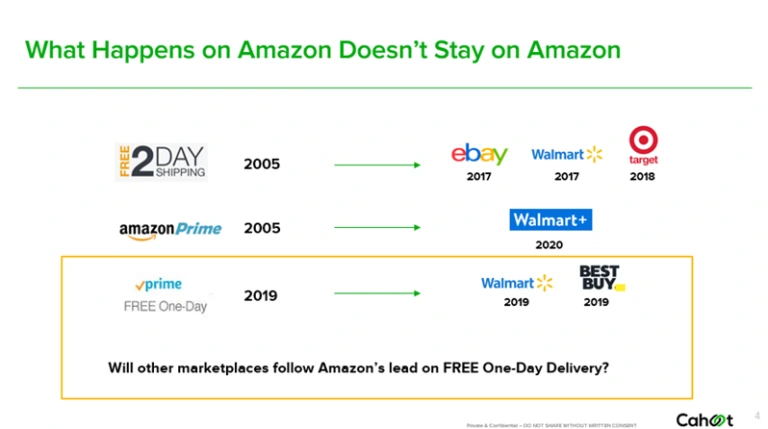
It took other marketplaces many years to copy Prime and offer free 2-day shipping, but recently the pace of change has rapidly accelerated. In 2019, Amazon, Walmart, and BestBuy all introduced free 1-day delivery in select areas. Expectations are about to rise again, though. As of February of 2021, Amazon sellers that self-fulfill orders under the Seller Fulfilled Prime program must make and keep a one calendar-day delivery promise on at least 20% of their page views (up from 0%). They won’t stop there, either – in August 2021, Amazon announced that it’s rolling out “faster Same-Day Delivery” to six test cities, and they’ll deliver packages in “just a few hours” (Amazon).
The upshot is that free two-day shipping has become table stakes in the eCommerce world, and customers expect it everywhere they shop. Today, 44% of consumers expect orders to arrive in 2 days or less (AT Kearney), and 75% expect delivery to be free even on orders under $50 (NRF). Even with marketplaces and websites partially catching up, Amazon remains the standard. According to a recent study by Wunderman Thompson, 75% of consumers wish that more brands offered the same level of service as Amazon.
How Does Fast and Free Shipping Impact Conversion Rates and Sales?
Shipping costs, transit times, and estimated delivery dates all impact conversion rates and sales. Amazon sellers that offer free Prime shipping see sales increase by as much as 50%, and Walmart reports that free 2-day shipping lifts conversion rates on its marketplace by 50%. A wide variety of consumer and merchant surveys repeatedly underscore the power of fast, free, and date-certain shipping. Let’s look at the impact of fast and free shipping and estimated delivery dates across the eCommerce landscape.
Paid Shipping vs. Free Shipping
- Paid
- 63% of cart abandonment is due to too high shipping costs (Statista)
- Free
- 77% of online shoppers say that free shipping is the most important option during checkout (UPS)
Slow Shipping vs. Fast Shipping
- Slow
- 36% of cart abandonment is because shipping takes too long (Statista)
- 84% of consumers are unlikely to return after just one negative delivery experience (Convey)
- Fast
- 25% increase in conversions from 2-day shipping (UPS)
- 87% of consumers were more likely to shop with a merchant again following a positive delivery experience (Metapack)
Vague Transit Times vs. Estimated Delivery Dates
- Vague Transit Times
- 45% of shoppers have abandoned carts due to unsatisfactory delivery options (Metapack)
- 64% of shoppers look for delivery options before putting items in the cart (Metapack)
- Estimated Delivery Dates
- 83% of shoppers rate estimated delivery dates as “Important” (Forrester)
- 38% reduction in cart abandonment when adding estimated delivery dates (FenixCommerce)
Customers are clear – if a seller doesn’t offer fast and free shipping, the seller won’t win their business. In a world in which Amazon and other marketplaces continually drive customer expectations higher, how can a merchant keep up on their website?
How to Increase Conversion Rates and Reduce Ad Spend with Fast and Free Shipping
Sellers don’t intuitively connect CPC and Ad Spend with shipping, but they’re more intertwined than they think. Most know that lower conversion rates have a negative compounding effect on ad spend, so they spend a lot of time and resources on conversion rate optimization (CRO). They work hard on reducing the time it takes to load pages, tweaking copy, and removing clicks from the checkout process. Without great shipping offers, though, all that effort goes to waste.
When shoppers abandon shopping carts, merchants not only lose customers, but they also see lower overall site conversion. Google considers this, so naturally, lower site conversion leads to higher Cost Per Click (CPC). This then drives higher ad spend to get the same traffic. Higher ad spend eats into profit margins, which over time can result in higher and less competitive pricing, which in turn further reduces conversion rates. Beware – this negative reinforcement loop can be challenging to escape.
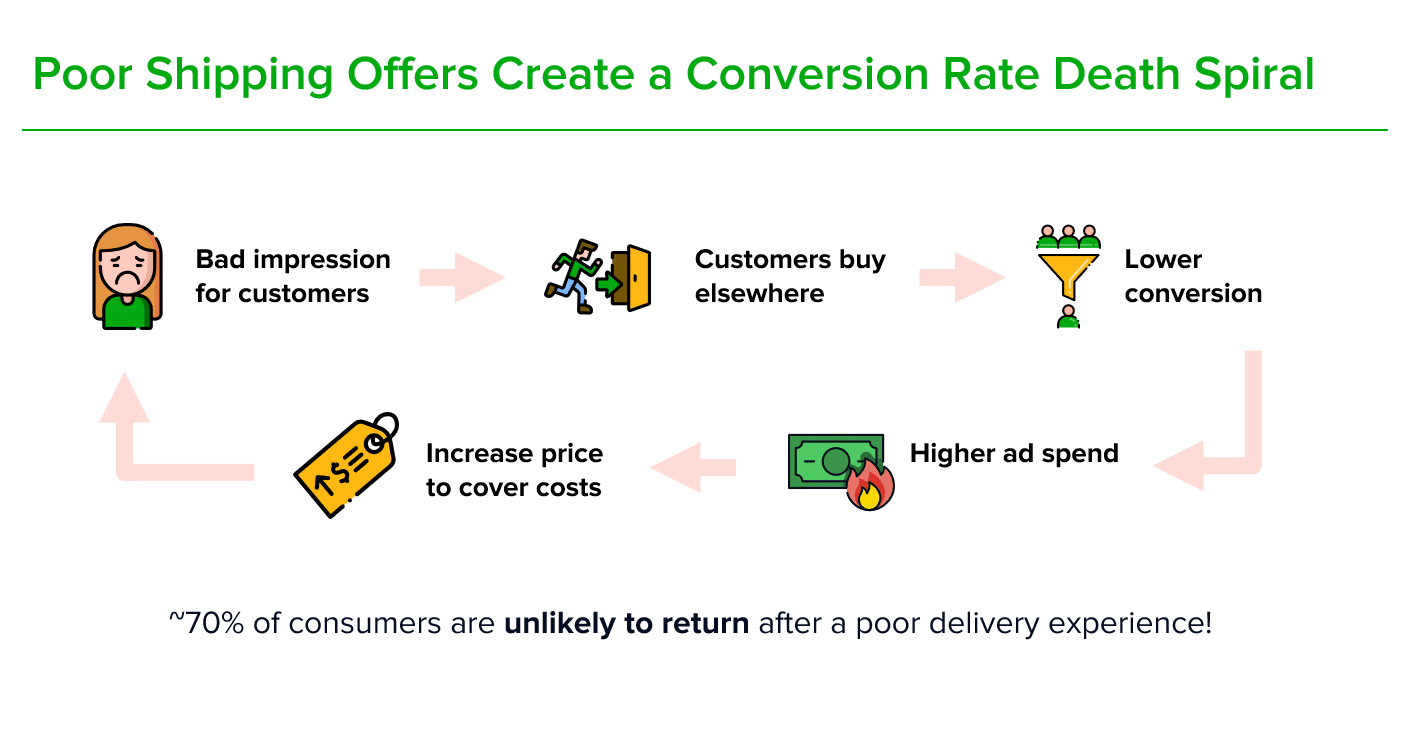
Fast and free shipping offers that include estimated delivery dates further improve CRO by reducing uncertainty and increasing buyer confidence. For example, merchants that use delivery experience platforms like FenixCommerce see cart abandonment rates go down on average of 38%. Contrary to those with high cart abandonment, these merchants enjoy positive reinforcement loops in which they can reinvest earnings from higher conversion into more ad spend. Their higher conversion also lowers their CPC, further increasing their ability to beat the competition. Keeping customers happy at the end of checkout drives improvement across the buying process.
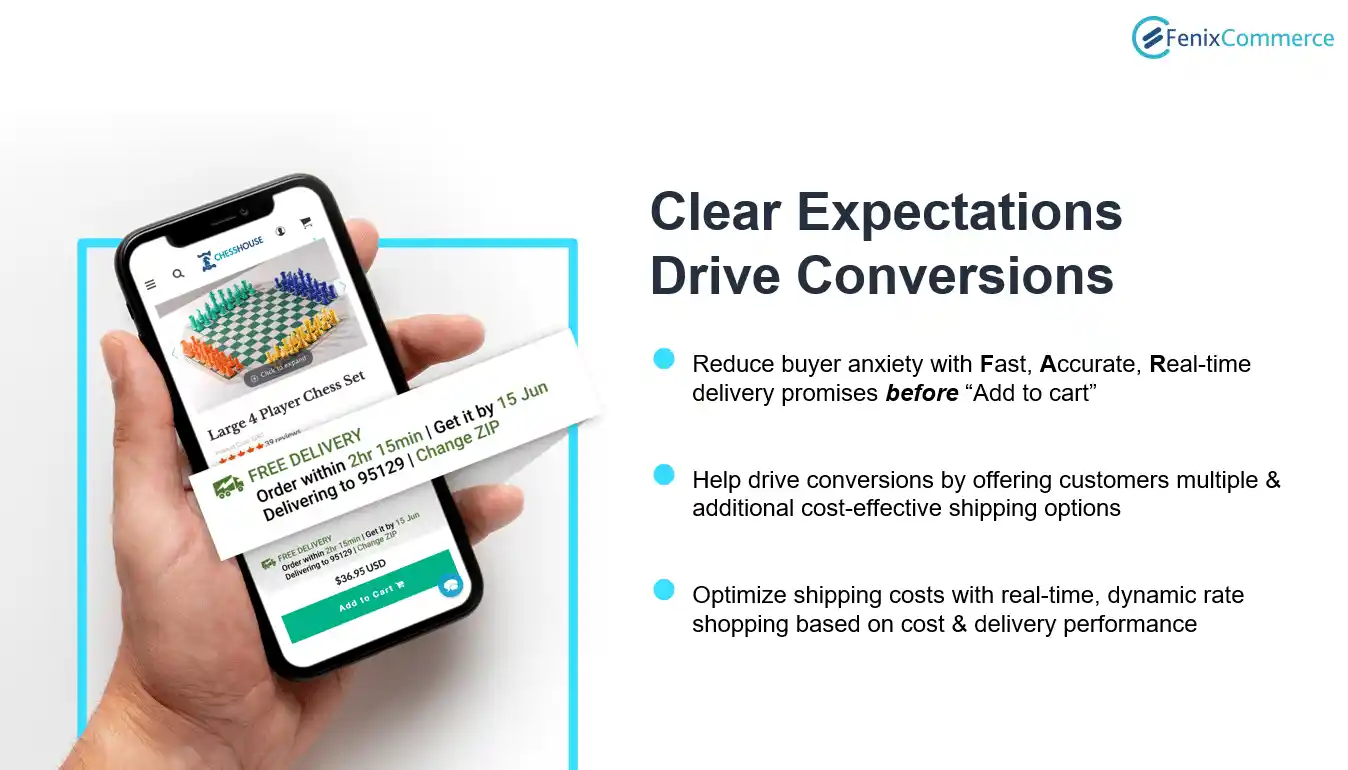
“Cahoot has amazing technology in addition to their large warehouse network, sort of like FBA but without the hefty fees or restrictions. Cahoot saved our peak-selling season!”
– Joel Frankel, Fames Chocolates
How To Affordably Offer Fast and Free Shipping – Everywhere You Sell
Many brands want to offer fast and free shipping for all of their channels to compete with marketplaces, but don’t have a clear picture of how to do it. Consequently, many brands that sell on their websites and marketplaces have steered themselves into complex, expensive fulfillment strategies to keep up.
On Amazon, they’ll use FBA where they can – but few sellers can put everything they want into FBA. So then they need a backup to FBA, which will often be their own warehouse. They might then contract with a 3PL when they add Walmart and other marketplaces, and all of a sudden, they’re trying to manage inventory and fulfillment with three or more fulfillment providers. This is no easy task. Because of each marketplace’s different fast shipping badge requirements and inventory restrictions of each fulfillment channel, sell-through is often inconsistent.
Frustrated with an impossible to optimize fulfillment network made up of a hodgepodge of fulfillment partners, savvy brands have been turning to omnichannel fulfillment solutions designed for eCommerce. With a large and growing number of USA fulfillment centers, they’re able to meet their clients’ needs today and are ready to adapt as customer expectations change in the future. Amazon MCF checks many of the same boxes, but it’s more expensive for fulfilling non-Amazon orders. Tech-enabled 3PLs can cover 2-day, but they don’t meet the up-and-coming 1-day delivery standard. And importantly for omnichannel sellers, neither option plays well with merchants’ in-house fulfillment.
|
|
 |
Amazon MCF |
3PL Networks |
|---|---|---|---|
|
Meets Current 2-Day Nationwide Delivery Standard |
|
|
|
|
Meets New 1-Day Nationwide Delivery Standard
|
|
|
|
|
Affordable on Your Website
|
|
|
|
|
Affordable Fulfillment on All Marketplaces
|
|
|
|
|
Qualifies For Fast Shipping Badges on Amazon & Walmart
|
|
|
|
|
Merchant-Inclusive Fulfillment
|
|
|
|
|
Option to Make Money Fulfilling for Others
|
|
|
|
Join a Peer-To-Peer Fulfillment Network
Many high-volume brands are switching to peer-to-peer (P2P) eCommerce order fulfillment for its high fulfillment standards, increased flexibility, and lower costs. Peer-to-peer fulfillment lowers fulfillment fees for its customers because it enables merchants to leverage underutilized warehouse space and ship merchandise for other sellers – think AirBnb for fulfillment. Moreover, fees are uniform across marketplaces and websites, and there are no peak-season surcharges. To learn more about aligning fulfillment with sales, check out How To Build an Effective MultiChannel Fulfillment and Sales Strategy.
P2P fulfillment networks run on an omnichannel fulfillment platform that seamlessly routes orders from eCommerce platforms like Shopify, BigCommerce, and Magento and marketplaces like Amazon, Walmart, and eBay. Such platforms simplify fulfillment by providing complete visibility of inventory, order, and delivery status throughout the network.
Reduce Anxiety and Cart Abandonment with Estimated Delivery Times
To further boost conversion rates, brands are turning to delivery experience platforms like FenixCommerce that offer estimated delivery dates. These are easy add-ons for any website. They utilize transit time information from carriers and fulfillment metrics from eCommerce platforms to determine accurate estimated delivery times.
Maximize Same-Day Fulfillment with Next-Gen Shipping Software
Many brands that use in-house fulfillment are dreading the upcoming “Shippagedon.” This year, seasonal labor will be in short supply and more expensive than ever, so warehouse teams will be pushed to the limit. Maximizing same-day fulfillment capacity during peak season is crucial, but with traditional shipping software like ShipStation, it can take hours each day to rate shop and route orders – even with complex shipping rules in place.
Brands should consider switching to next-generation shipping software that offers automatic routing and rate shopping and eliminates all of the busy manual work of traditional shipping software. With an automated ShipStation alternative, all shipping labels are ready before the warehouse team arrives, so they can start picking orders first thing in the morning. When the cheapest shipping labels are generated automatically, merchants can easily extend their same-day shipping cutoff time later in the day. As a result, merchants significantly increase same-day fulfillment capacity while reducing fulfillment labor costs by as much as 40%.
Recap
Brands have launched incredible web stores to boost customer loyalty and improve margins, but marketplaces continue to dominate the eCommerce landscape. The reason is simple – customers expect fast and free shipping with estimated delivery dates, and that’s the norm on marketplaces and the exception on brand sites.
To catch marketplaces, many brands have built piecemeal fulfillment strategies that sometimes address the immediate challenge but also leave them unable to adapt as customer expectations change quickly. To offer fast and free shipping across all channels now and in the future, you need an innovative fulfillment partner that works flexibly across sales channels and integrates seamlessly with existing strategies. Then, further increase your conversion with estimated delivery dates that will delight your customers. And finally, make the switch to next-gen shipping software to maximize same-day fulfillment.
The good news is that with the right tools, offering an Amazon-like delivery experience is more accessible and less expensive than ever. In addition to winning back business from Amazon, such a strategy lowers costs, increases margins, and gives you a distinct advantage over other eCommerce competitors in your industry.
